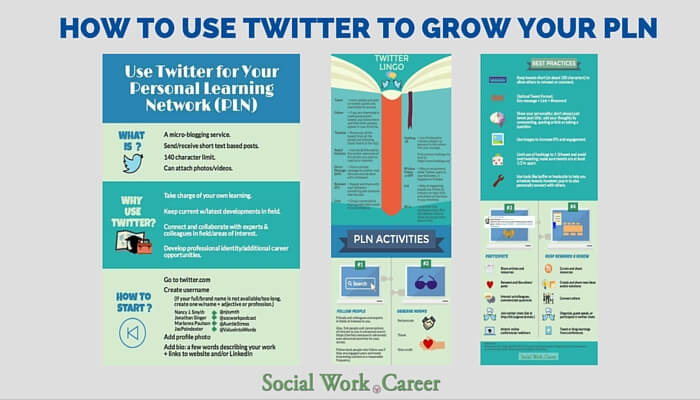Personal Learning Networks: Why (& How) to Use Twitter
Have you heard about twitter but are concerned that it is too hard to figure out, or may have no relevance to you? Would you like to know how you may use twitter to help you learn about different topics and/or advance in your career?
This post will provide you with the key steps to understand twitter and use it to establish your own personal learning network. A Personal Learning Network (PLN) is a group of individuals from whom you may learn from, collaborate with and exchange resources with.
If you haven’t tried twitter out yet, or have only done so without a guide, it could have given you the false impression of being a place of where people talk about what they ate for breakfast and other unimportant matters. However, once you learn the lingo and some of its best practices, you will see that twitter can provide you with a valuable and continuously evolving library of information and ideas on every topic! It will also give you the opportunity to meet experts, whom you would not normally meet, from a variety of different fields.
Below are the most important steps you need to know, described both in text and a graphic. And for those of you who are interested, here is how I began my journey on twitter in this interview with Pat Shelly at UBSSW’s InSocialWork’s podcast.
You can also join me in January when I teach an online class on how to use social media to advance your career at the University of Buffalo!
How to Build Your Personal Learning Network with Twitter
- Create a Twitter Profile
- Create your username – it is best to use your name, brand name or some combination of name + adjective or profession (the shorter, the better)
- Add a professional/profile photo
- Add a background header photo (if possible) related to your profession/brand
- Add a bio – include a few words describing your work + links to website/linkedIn URL(s)
- Follow People
- Search for people and conversations of interest using twitter’s advanced search tool
- See whom your friends and experts in your field follow
- Search for keywords among twitter hashtags in either Twubs or Hashtagify.me to find the best ones based on their popularity and other metrics
- Observe Norms
- Reciprocate (share, offer support in kind etc.)
- Thank for RTs
- Give credit where credit is due
- Participate (Employing Best Practices)
- Share high quality articles and resources
- Retweet and like/bookmark others’ posts
- Interact with colleagues
- Join twitter chats http://www.bit.ly/generalchats
- Attend online conferences/webinars
- Reap Rewards and Renew
- Curate and share resources
- Create and share new solutions/ideas
- Connect others
- Organize/guest speak at twitter chats
- Tweet/blog learnings from conferences (storify is an alternate way of archiving/sharing the most important tweets from a twitter chat/event)
Excellent Resources
- Jacob Share’s Ultimate Twitter Job Search Guide
- Jonathan Singer’s Using Social Media to Expand the Reach of Academic Conferences
- Kristie Holmes’ Twitter for Social Workers, Beginner’s Edition
- Laurel Hitchcock’s Online Toolkit for Developing a Personal Learning Network (PLN) with Twitter
- Nancy Smyth’s Twitter 101
- Sean Erreger’s Connecting Twitter Communities…
- Social Work Career’s Online Toolkit for New Social Workers
- UBSSW’s Social Worker’s Guide to Social Media
Nov 7, 2017 Update: Twitter has expanded its character limit from 140 characters to 280 characters!
Like this post? Please share it!
References:
Richardson, W., & Mancabelli, R. (2011). Personal learning networks: Using the power of connections to transform education. Bloomington, IN: Solution Tree Press.
Twitter, Inc. (2015). The Twitter glossary. Retrieved from https://support.twitter.com/articles/166337




What a terrific resource, Dorlee, thanks for creating this. I will be sharing this widely!!
Thanks so much, Nancy!
It was a natural outgrowth of the preparation for the course I’ll be teaching 🙂